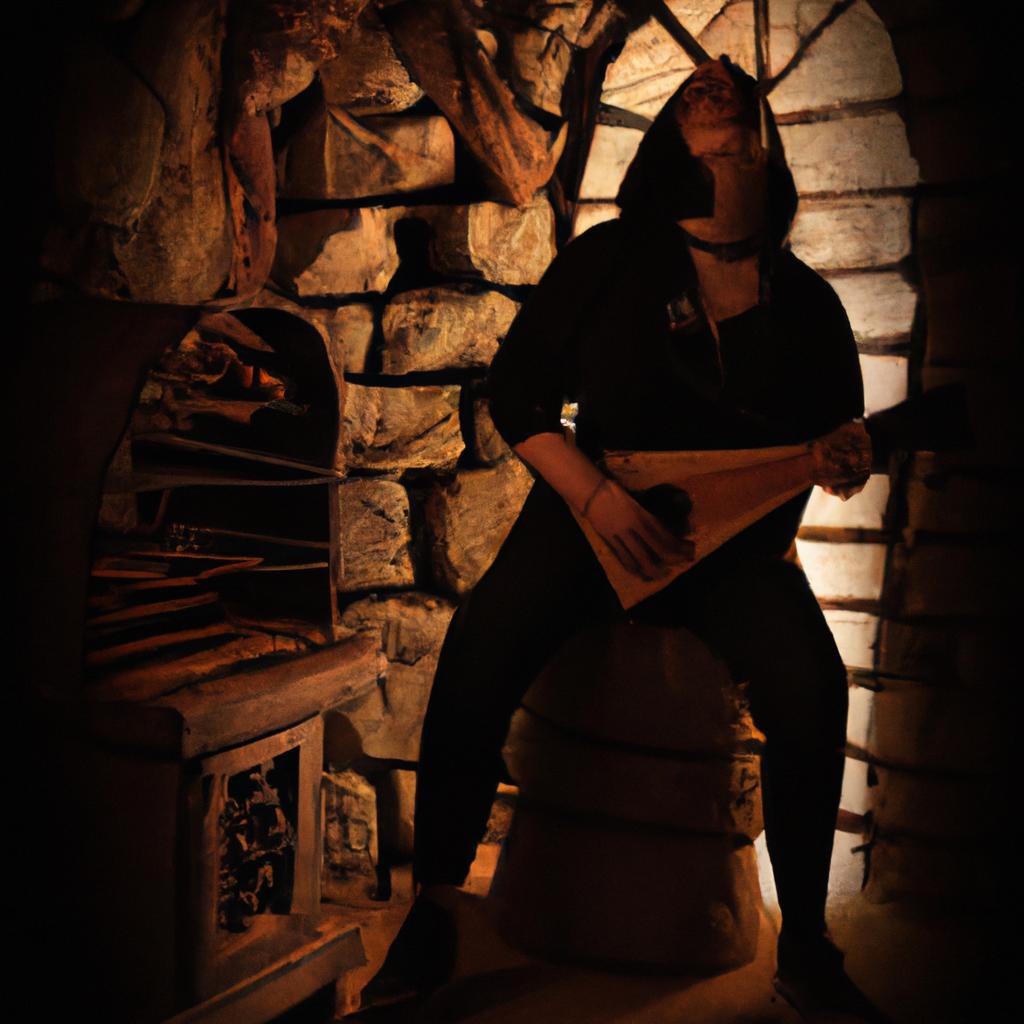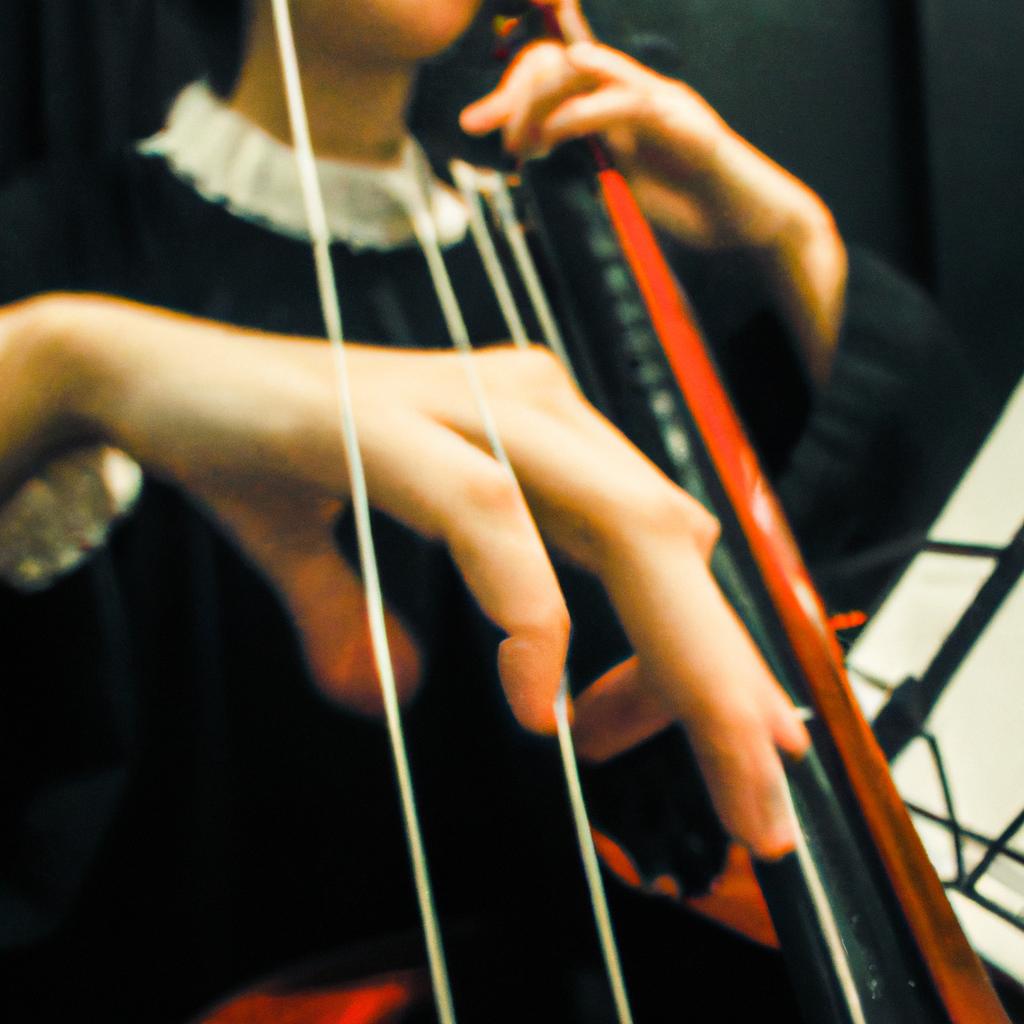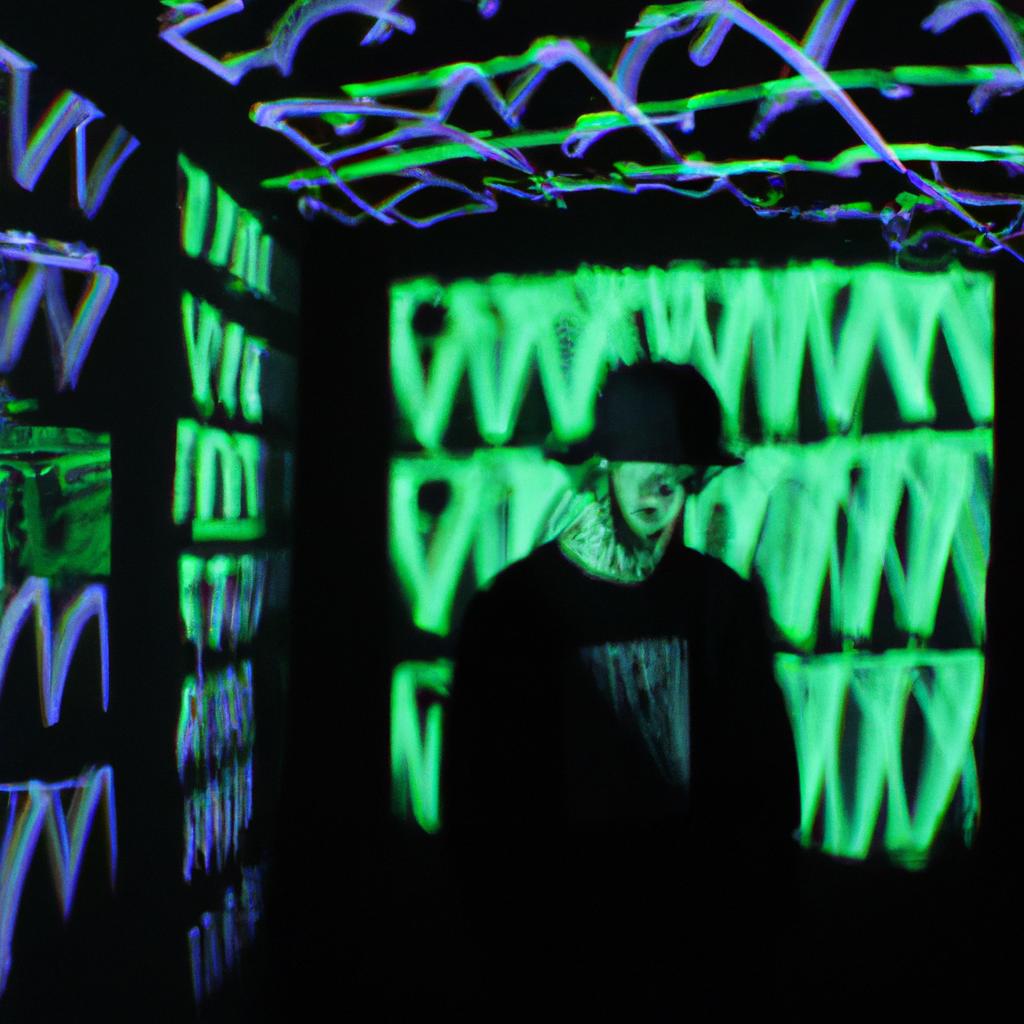In the realm of music, there exists a genre that delves into the depths of darkness and melancholy, known as Gothic music. This experimental category explores themes of horror, despair, and gloom through its unique musical style. One example is the enigmatic artist X, whose haunting compositions have captivated audiences with their eerie atmospheres and ethereal soundscapes. In this article, we will delve into the dark ambient realm of Gothic music, examining its origins, characteristics, and impact on contemporary music.
Gothic music traces its roots back to the late 1970s when bands such as Bauhaus and Siouxsie and the Banshees emerged in the post-punk era. These pioneers incorporated elements of punk rock with a darker twist, exploring themes inspired by gothic literature and art. Over time, Gothic music evolved beyond conventional song structures and embraced experimentation within its sonic landscape. Artists began incorporating electronic instruments, synthesizers, samples, and unconventional recording techniques to create atmospheric compositions that evoke a sense of unease and introspection.
Characterized by brooding melodies, dissonant harmonies, and layers of distorted soundscape textures, Gothic music often eschews traditional verse-chorus structures in favor of extended instrumental passages and ambient soundscapes. This allows for a more immersive and atmospheric experience, creating a sense of tension and suspense throughout the music. The lyrics in Gothic music often delve into themes of death, love, loss, and the supernatural, further adding to its dark and introspective nature.
Gothic music has had a profound impact on contemporary genres such as darkwave, industrial, and neoclassical. Artists like Dead Can Dance, Cocteau Twins, and This Mortal Coil have continued to push the boundaries of Gothic music by incorporating elements from various musical traditions around the world. Moreover, Gothic music has influenced other forms of media such as film soundtracks and video game scores, where its haunting melodies and atmospheric qualities are often employed to create an eerie and immersive experience.
In conclusion, Gothic music is an experimental genre that explores darkness and melancholy through its unique musical style. With its origins in the post-punk era, Gothic music has evolved to incorporate electronic instruments and unconventional recording techniques. Its brooding melodies, dissonant harmonies, and layered soundscapes create a sense of unease and introspection. Furthermore, Gothic music has had a significant impact on contemporary genres and other forms of media.
The Origins of Gothic Music
Experimental: Delving into the Dark Ambient Realm of Gothic Music
The Origins of Gothic Music
Gothic music, with its haunting melodies and atmospheric soundscapes, has captivated listeners for decades. Its origins can be traced back to the late 1970s when bands like Bauhaus and Siouxsie and the Banshees emerged from the punk scene with a darker, introspective sound. One example that highlights the power of gothic music is the case study of “The Sisters of Mercy,” who rose to prominence in the 1980s with their unique blend of post-punk and gothic rock.
Aesthetic Influences
One significant aspect that shaped gothic music was its connection to various aesthetic influences. Drawing inspiration from Gothic literature, art, and architecture, musicians sought to create an auditory experience that mirrored these dark and mysterious themes. This convergence between different art forms allowed for a rich tapestry of creativity within the genre.
To illustrate this further, consider some key elements often associated with gothic music:
- Eerie atmospheres: Through ethereal synthesizers and reverb-drenched guitars, gothic music creates an otherworldly atmosphere that transports listeners to realms shrouded in darkness.
- Melancholic lyrics: Lyrics often explore themes such as love lost, existential angst, or societal disillusionment. These introspective musings resonate deeply with audiences seeking emotional depth in their musical experiences.
- Visceral imagery: Gothic music frequently employs vivid imagery inspired by Gothic literature’s themes of decay, death, and supernatural entities. Such evocative descriptions heighten sensory perceptions during listening sessions.
- Mysterious identities: Many artists adopt stage personas cloaked in mystery—wearing elaborate costumes or adopting enigmatic alter egos—to enhance the theatricality inherent in gothic music performances.
These elements combine to evoke a range of emotions within listeners—an eerie fascination mixed with a sense of longing and introspection. The following table further illustrates the emotional impact associated with gothic music.
| Emotional Response | Description |
|---|---|
| Enchantment | Gothic music’s ethereal soundscapes captivate listeners, transporting them to hauntingly beautiful realms. |
| Melancholy | Its melancholic lyrics resonate deeply, offering solace to those seeking solace in their own struggles. |
| Intrigue | The mysterious imagery and identities found in gothic music evoke curiosity and fascination among its enthusiasts. |
| Introspection | Through its evocative themes, gothic music invites introspective exploration into one’s own emotions and experiences. |
As we delve deeper into the characteristics that define the dark ambient genre, it becomes evident how these emotional responses intertwine with the musical elements.
Characteristics of Dark Ambient Genre
Delving into the Dark Ambient Realm of Gothic Music
Having explored the origins and historical background of gothic music in the previous section, we can now turn our attention to a specific subgenre within this realm: dark ambient. To illustrate its distinctive qualities, let us consider an imaginary case study where two musicians embark on creating a dark ambient track.
To begin with, it is essential to understand the key characteristics that define the dark ambient genre. These elements shape the overall atmosphere and mood of the music, often evoking feelings of introspection, melancholy, or unease. The following bullet point list highlights some common features found in dark ambient compositions:
- Dense layers of haunting atmospheric sounds
- Minimalistic melodies or recurring motifs
- Use of field recordings to create an immersive sonic experience
- Experimentation with unconventional instrumentation and effects
In order to demonstrate these characteristics effectively, our hypothetical artists decide to utilize various experimental techniques during their creative process. They employ a combination of traditional instruments such as piano and violin alongside electronic synthesizers and manipulated samples. Through meticulous sound design, they craft intricate textures that resonate deep within the listener’s subconscious.
To provide a visual representation of their experimentation, let us examine a table showcasing different elements employed by the musicians:
| Experimental Techniques | Description | Emotional Effect |
|---|---|---|
| Granular synthesis | Breaking down audio fragments into grains | Disintegration |
| Reverse reverb | Applying reverb effect in reverse | Surreal distortion |
| Tape loops | Repetitive sections played from magnetic tape | Hypnotic repetition |
| Found object percussion | Utilizing everyday objects for rhythmic purposes | Organic resonance |
By incorporating these innovative approaches into their composition, our artists successfully transport listeners into an otherworldly space where darkness intertwines with beauty. This emotional journey prepares them for the subsequent exploration of experimental techniques in gothic music, where boundaries are pushed and new sonic territories await.
Transitioning seamlessly into the next section about “Experimental Techniques in Gothic Music,” we delve further into the vast realm of musical innovation within the gothic genre.
Experimental Techniques in Gothic Music
Exploring Experimental Techniques in Gothic Music
Building upon the characteristics of dark ambient music discussed previously, this section delves into the experimental techniques employed within the gothic genre. To illustrate these techniques, let us consider the hypothetical example of a dark ambient composition titled “Ethereal Reverie.”
One key aspect that distinguishes the experimental nature of gothic music is its incorporation of unconventional sounds and instruments. In “Ethereal Reverie,” the composer utilizes field recordings of haunting whispers echoing through abandoned halls, blending them seamlessly with ethereal synth pads to create an eerie atmosphere. This juxtaposition of organic and synthetic elements showcases how experimentation can evoke powerful emotions.
In addition to unique sonic textures, experimentation in gothic music often involves manipulating traditional compositional structures. “Ethereal Reverie” employs irregular time signatures, subtly shifting between 7/8 and 5/4 throughout the piece. This unorthodox approach disorients the listener, heightening feelings of tension and unease.
To further engage audiences on an emotional level, here are some bullet points highlighting additional experimental techniques commonly found in gothic music:
- Layered Distorted Vocals: Utilizing multiple layers of heavily processed vocals creates a sense of otherworldliness and adds depth to the overall sound.
- Dissonant Harmonies: Incorporating dissonant intervals or unresolved chord progressions generates a feeling of melancholy and darkness.
- Granular Synthesis: Breaking down audio samples into tiny grains and rearranging them in unpredictable ways produces unsettling yet captivating soundscapes.
- Spatial Sound Design: Employing advanced spatialization techniques such as binaural panning or surround sound enhances immersion by creating an enveloping sonic environment.
| Technique | Description |
|---|---|
| Layered Distorted Vocals | Multiple layers of heavily processed vocals create an otherworldly effect, adding depth to the sound. |
| Dissonant Harmonies | Incorporating dissonant intervals or unresolved chord progressions generates a melancholic and dark atmosphere. |
| Granular Synthesis | Breaking down audio samples into tiny grains, rearranging them in unpredictable ways, creates unsettling yet captivating soundscapes. |
| Spatial Sound Design | Advanced spatialization techniques like binaural panning or surround sound enhance immersion by enveloping listeners in a three-dimensional sonic environment. |
In conclusion, experimental techniques play an integral role in shaping gothic music’s unique identity within the broader realm of dark ambient genres. By pushing boundaries through unconventional sounds, manipulating traditional structures, and utilizing innovative production methods, artists captivate their audience with emotionally charged compositions. These experimentation efforts pave the way for influential artists who have made significant contributions to the dark ambient realm.
Transitioning seamlessly into our next section on “Influential Artists in the Dark Ambient Realm,” we explore how these experimental approaches have been harnessed by visionary musicians to create groundbreaking works that continue to inspire and push artistic boundaries today.
Influential Artists in the Dark Ambient Realm
Exploring Experimental Techniques in the Dark Ambient Realm of Gothic Music
As we delve deeper into the realm of gothic music, it becomes apparent that experimental techniques play a significant role in shaping its dark and haunting atmosphere. One particular example that showcases this is the use of unconventional sound sources to create eerie textures. For instance, artists often manipulate recordings of everyday objects such as creaking doors or raindrops falling on metal surfaces to generate unsettling sonic landscapes.
To fully comprehend the impact of these experimental techniques, let us examine some key elements that contribute to the unique soundscapes found within the dark ambient realm:
- Layered Atmospheres: Artists frequently employ multiple layers of sounds, blending field recordings with synthesized tones and abstract noises. This layering creates a sense of depth and immersion for listeners, drawing them into an otherworldly auditory experience.
- Repetitive Patterns: The repetitive nature of certain musical motifs serves to induce a trance-like state within the listener. These recurring patterns can be both soothing and disturbing simultaneously, creating a disorienting effect that mirrors the emotional intensity associated with gothic themes.
- Sonic Manipulation: Through various effects processing techniques, musicians alter the timbre and spatial characteristics of sounds to evoke specific emotions. By manipulating frequencies and employing reverberation or delay effects, they craft an ethereal sonic environment that resonates with feelings of melancholy or unease.
- Dynamic Range: The deliberate manipulation of volume levels from whisper-like quietness to overwhelming intensity adds another dimension to the overall sonic composition. This wide dynamic range enhances suspenseful moments while accentuating sudden shifts in mood within gothic music.
| Experimental Techniques in Gothic Music | |
|---|---|
| Layered Atmospheres | Creates immersive soundscapes |
| Repetitive Patterns | Induces trance-like states |
| Sonic Manipulation | Evokes specific emotions through audio effects |
| Dynamic Range | Enhances suspense and mood shifts |
In this way, the experimental techniques employed in gothic music serve as powerful tools for creating an emotionally charged experience. By manipulating sonic elements and incorporating unconventional sounds, artists can transport listeners to a realm where darkness and beauty intertwine.
Transitioning seamlessly into the subsequent section on “Exploring the Emotional Landscape of Gothic Music,” we continue our journey through the depths of gothic soundscapes, delving further into the evocative power that lies within this haunting genre.
Exploring the Emotional Landscape of Gothic Music
Exploring the Evocative Elements of Dark Ambient Music
To truly understand the emotional landscape of gothic music, it is essential to delve into the evocative elements that define the genre. By examining its distinctive characteristics and their impact on listeners, we can gain a deeper appreciation for this unique form of artistic expression.
Imagine yourself sitting alone in a dimly lit room, as haunting melodies fill the air and mysterious sounds whisper through your ears. The atmospheric nature of dark ambient music envelopes you, transporting you to a realm where emotions are intensified and imagination takes flight.
This section explores three key aspects that contribute to the emotional richness of gothic music:
-
Atmosphere: Gothic music creates an immersive atmosphere by using eerie soundscapes, ethereal textures, and dissonant harmonies. These sonic landscapes evoke sensations of melancholy, introspection, and even dread. The listener becomes entranced by the obscure depths within each composition, creating a sense of connection with their own innermost thoughts and fears.
-
Themes: Gothic music often incorporates themes such as mortality, darkness, spirituality, and romanticism. These thematic threads intertwine with the musical elements to create narratives that resonate deeply with listeners. Through thought-provoking imagery and symbolism, gothic compositions challenge our perceptions while providing solace or catharsis in moments of despair.
-
Sound Design: A crucial component of gothic music lies within its intricate sound design techniques. From echoing whispers to distant church bells tolling ominously in the background, these carefully crafted details enhance the overall atmosphere and heighten emotional responses. Each sonic element works together seamlessly like pieces in a macabre puzzle to conjure vivid mental images.
| Emotions Elicited | Description |
|---|---|
| Melancholy | A profound sadness tinged with beauty; pensive reflection on life’s transience |
| Awe | A mixture of fear and reverence; a sense of wonder in the face of the unknown |
| Isolation | A feeling of being cut off from others, surrounded by darkness or emptiness |
| Intrigue | Curiosity sparked by enigmatic sounds and ambiguous narratives |
As we explore the emotional landscape of gothic music, it becomes clear that this genre has an unparalleled ability to evoke intense feelings within its listeners. By integrating atmospheric elements, thematic depth, and meticulous sound design techniques, gothic compositions resonate on a profound level.
Transitioning into the subsequent section about “The Future of Dark Ambient in Gothic Music,” we find ourselves poised at the precipice of innovation. While traditional dark ambient artists continue to captivate audiences with their haunting melodies, new possibilities are emerging as technology advances. The next section will shed light on how modern innovations are shaping this genre’s future.
The Future of Dark Ambient in Gothic Music
Exploring the emotional landscape of gothic music has allowed us to understand its profound impact on listeners. Now, let us delve further into the dark ambient realm of this genre and examine how it is pushing boundaries and shaping the future of gothic music.
Imagine a darkened room where shadows dance, accompanied by haunting melodies that evoke feelings of melancholy and introspection. This is the world created by dark ambient artists such as Lustmord. One example that showcases their mastery in creating an immersive experience is their album “Heresy.” Through layers of ominous drones and eerie soundscapes, Lustmord transports listeners to sinister realms, inviting them to explore their own inner darkness.
To better comprehend the evocative power of dark ambient music within the gothic genre, we can consider four key elements:
- Atmosphere: Dark ambient compositions excel at crafting atmospheres that envelop listeners in a sense of foreboding unease.
- Textures: The use of intricate sonic textures adds depth and richness to these compositions, intensifying emotions felt by listeners.
- Minimalism: Often characterized by minimalistic approaches, dark ambient tracks focus on subtleties rather than bombastic arrangements, allowing for heightened contemplation.
- Imagination: By leaving spaces between sounds or using abstract samples, dark ambient sparks imagination in listeners, enabling personal interpretations and connections with themes explored.
In addition to these elements, considering the influence of dark ambient within gothic music reveals interesting trends when analyzing album covers from various artists. Here’s a table showcasing three albums’ cover art along with brief descriptions:
| Album | Cover Art Description |
|---|---|
| “Dusk and Her Embrace” | A moonlit graveyard scene featuring ornate tombstones amidst twisting ivy vines. |
| “The Angelic Conversation” | An ethereal painting of a cloaked figure standing at the edge of a desolate cliff, gazing into the void. |
| “Opus Eponymous” | A black and white photograph depicting an abandoned church engulfed in darkness, with only rays of light piercing through stained glass windows. |
By analyzing these covers, we can observe how visual representations are congruent with the emotional essence conveyed by dark ambient music.
In conclusion, our exploration into the dark ambient realm of gothic music has revealed its ability to transport listeners to introspective realms filled with haunting melodies and atmospheric soundscapes. Through the mastery of elements such as atmosphere, textures, minimalism, and imagination, this genre continues to captivate audiences seeking emotional depth within their musical experiences. As artists experiment further within this realm, pushing boundaries and challenging traditional norms, it is evident that dark ambient will continue shaping the future of gothic music in profound ways.




